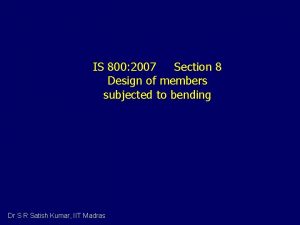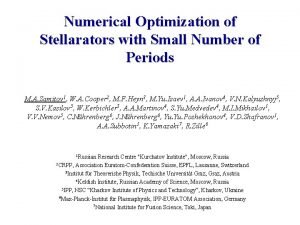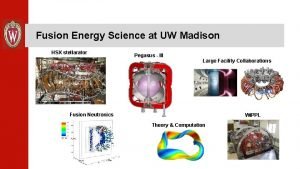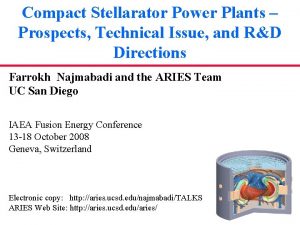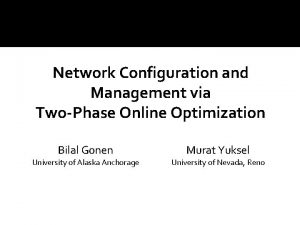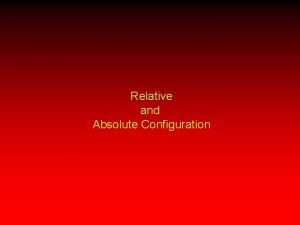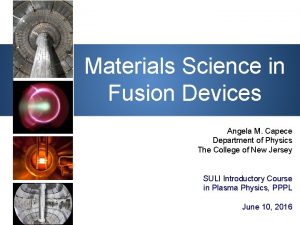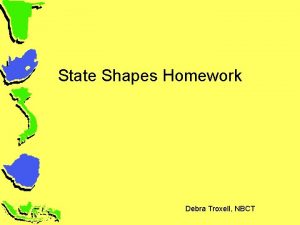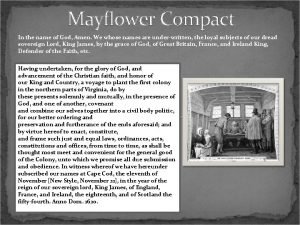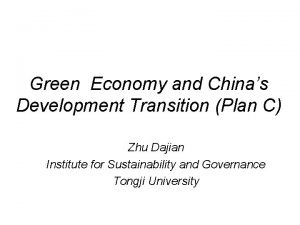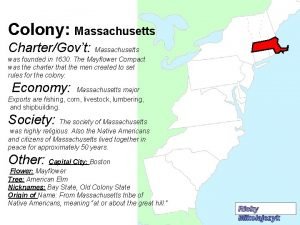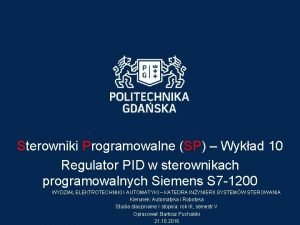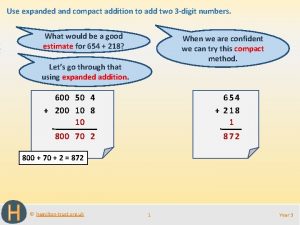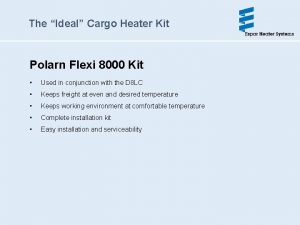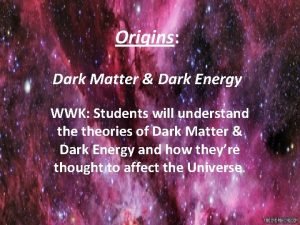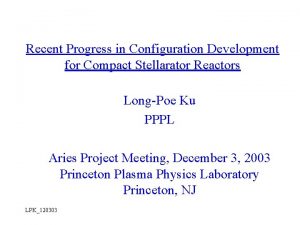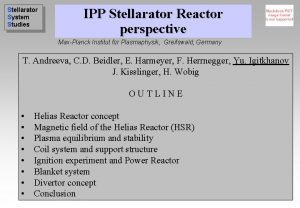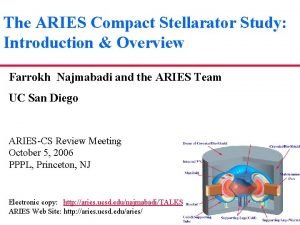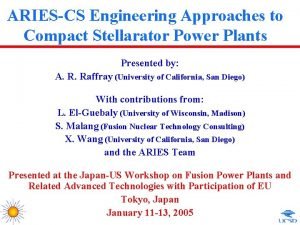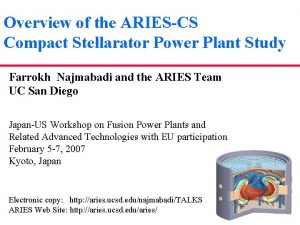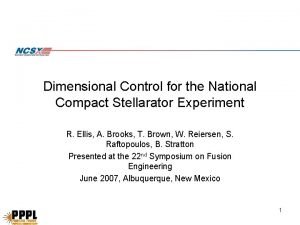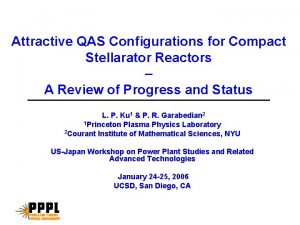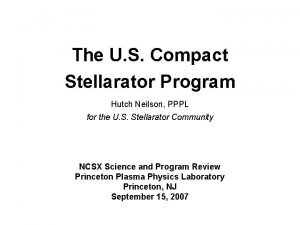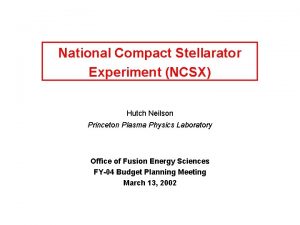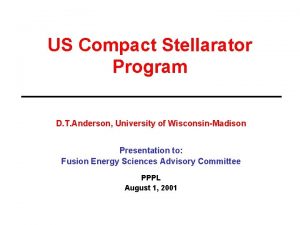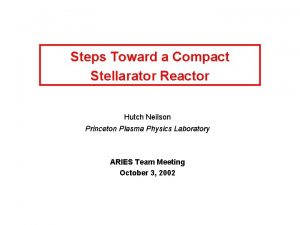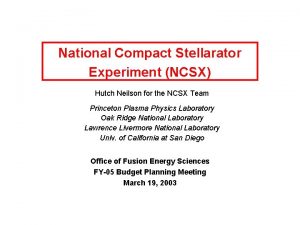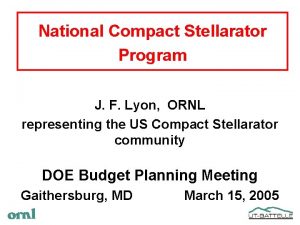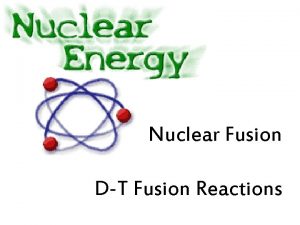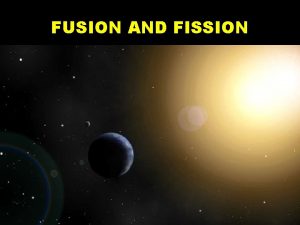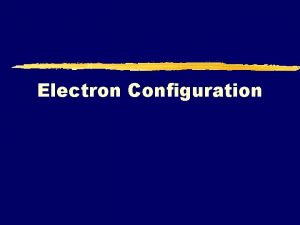Optimization of Compact Stellarator Configuration as Fusion Devices


























- Slides: 26

Optimization of Compact Stellarator Configuration as Fusion Devices Report on ARIES Research Farrokh Najmabadi and the ARIES Team UC San Diego OFES Briefing November 16, 2005 Germantown Electronic copy: http: //aries. ucsd. edu/najmabadi/TALKS ARIES Web Site: http: //aries. ucsd. edu/aries/

UC San Diego Boeing GA INEL GIT ORNL MIT PPPL RPI U. W. FKZ Collaborations For ARIES Publications, see: http: //aries. ucsd. edu/

ARIES-Compact Stellarator Program Has Three Phases FY 03/FY 04: Exploration of Plasma/coil Configuration and Engineering Options 1. Develop physics requirements and modules (power balance, stability, a confinement, divertor, etc. ) 2. Develop engineering requirements and constraints. 3. Explore attractive coil topologies. Present status FY 04/FY 05: Exploration of Configuration Design Space 1. Physics: b, A, number of periods, rotational transform, sheer, etc. 2. Engineering: configuration optimization, management of space between plasma and coils, etc. 3. Trade-off Studies (Systems Code) 4. Choose one configuration for detailed design. FY 06: Detailed system design and optimization

Goal: Stellarator Power Plants Similar in Size to Tokamak Power Plants Ø Multipolar external field -> coils close to the plasma Ø First wall/blanket/shield set a minimum plasma/coil distance (~1. 5 -2 m) Need a factor of 2 -3 reduction Ø A minimum minor radius Ø Large aspect ratio leads to large size. Ø Approach: ü Physics: Reduce aspect ratio while maintaining “good” stellarator properties. ü Engineering: Reduce the required minimum coil-plasma distance.

We have focused on Quasi-Axisymmetric stellarators that have tokamak transport and stellarator stability Ø In 3 -D magnetic field topology, particle drift trajectories depend only on the strength of the magnetic field not on the shape of the magnetic flux surfaces. QA stellarators have tokamak-like field topology. Ø Stellarators with externally supplied poloidal flux have shown resilience to plasma disruption and exceeded stability limits predicted by linear theories. Ø QA can be achieved at lower aspect ratios with smaller number of field periods. ü A more compact device (R<10 m), ü Bootstrap can be used to our advantage to supplement rotational transform, ü Shown to have favorable MHD stability at high b.

Typical Plasma Configuration Optimization Criteria Maximum residues of nonaxisymmetry in magnetic spectrum. ü neo-classical transport anomalous transport: overall allowable “noise” content < ~2%. effective ripple in 1/n transport, eeff < ~1% ü ripple transport and energetic particle loss a energy loss < ~10% Equilibrium and equilibrium b limits ü Shafranov shift < 1/2 ü large islands associated with low order rational surfaces flux loss due to all isolated islands < 5% ü overlapping of islands due to high shears associated with the bootstrap current ü limit di/ds Stability limits (linear, ideal MHD) ü vertical modes ü interchange stability: V″~2 -4%. LHD, CHS stable while having a hill. ü ballooning modes: stable to infinite-n modes LHD exceeds infinite-n results. High-n calculation typically gives higher b limits. ü kink modes: stable to n=1 and 2 modes without a conducting wall W 7 AS results showed mode (2, 1) saturation and plasma remained quiescent. ü tearing modes: di/ds > 0 Ø Each criteria is assigned a threshold and a weight in the optimization process.

Stellarator Operating Limits Differ from Tokamaks Ø Stellarators operate at much higher density than tokamaks Ø Limit not due to MHD instabilities. Density limited by radiative recombination Ø High-b is reached with high density (favorable density scaling in W 7 -AS) Ø High density favorable for burning plasma/power plant: ü Reduces edge temperature, eases divertor solution ü Reduces a pressure and reduces aparticle instability drive Greenwald density evaluated using equivalent toroida current that produces experimental edge iota

Stellarator b May Not Limited by Linear Instabilities Ø b > 3. 2 % for > 100 t. E (W 7 AS) Ø b > 3. 7 % for > 80 t. E (LHD) Ø Peak b Average flat-top b very stationary plasmas Ø No Disruptions Duration and b not limited by onset of observable MHD Ø Much higher than predicted b limit of ~ 2% (from linear stability) 2/1 mode ovserved, but saturates. Ø No need for feedback mode stabilization, internal coils, nearby conducting structures. Ø b-limit may be due to equilibrium limits.

Physics Optimization Approach NCSX scale-up Coils Physics 1) Increase plasma-coil separation 2) Simpler coils 1) Confinement of a particle 2) Integrity of equilibrium flux surfaces High leverage in sizing. Critical to first wall & divertor. Reduce consideration of MHD stability in light of W 7 AS and LHD results New classes of QA configurations MHH 2 SNS 1) Develop very low aspect ratio geometry 2) Detailed coil design optimization 1) Nearly flat rotational transforms 2) Excellent flux surface quality How compact a compact stellarator power plant can be? How good and robust the flux surfaces one can “design”?

Optimization of NCSX-Like Configurations: Increasing Plasma-Coil Separation ü A series of coil design with Ac=<R>/Dmin ranging 6. 8 to 5. 7 produced. ü Large increases in Bmax only for Ac < 6. ü a energy loss is large ~18%. LI 383 Ac=5. 9 For <R> = 8. 25 m: Dmin(c-p)=1. 4 m Dmin(c-c)=0. 83 m Imax=16. 4 MA @6. 5 T

Optimization of NCSX-Like Configurations: Improving a Confinement & Flux Surface Quality A bias is introduced in the magnetic spectrum in favor of B(0, 1) ü A substantial reduction in a loss (to ~ 3. 4%) is achieved. N 3 ARE Frequency *4096 LI 383 Energy (ke. V) ü The external kinks and infinite-n ballooning modes are marginally stable at 4% b with no nearby conducting wall. ü Rotational transform is similar to NCSX, so the same quality of equilibrium flux surface is expected.

Optimization of NCSX-Like Configurations: Improving a Confinement & Flux Surface Quality ü The external transform is increased to remove m=6 rational surface and move m=5 surface to the core Equilibrium calculated by PIES @4% b. KQ 26 Q ü May be unstable to free-boundary modes but could be made more stable by further flux surface shaping

Two New Classes of QA Configurations II. MHH 2 ü Low plasma aspect ratio (Ap ~ 2. 5) in 2 field period. ü Excellent QA, low effective ripple (<0. 8%), low a energy loss ( 5%). III. SNS ü Ap ~ 6. 0 in 3 field period. Good QA, low effective ripple (< 0. 4%), a loss 8%. ü Low shear rotational transform at high b, avoiding low order resonances.

a loss is still a concern Issues: Ø High heat flux (added to the heat load on divertor and first wall) Ø Material loss due to accumulation of He atoms in the armor (e. g. , Exfoliation of mm thick layers by 0. 1 -1 Me. V a’s): ü Experiment: He Flux of 2 x 1018 /m 2 s led to exfoliation of 3 mm W layer once per hour (mono-energetic He beam, cold sample). ü For 2. 3 GW of fusion power, 5% a loss, and a’s striking 5% of first wall area, ion flux is 2. 3 x 1018 /m 2 s). ü Exact value depend on a energy spectrum, armor temperature, and activation energy for defects and can vary by many orders of magnitude (experiments and modeling needed). Footprints of escaping a on LCMS for N 3 ARE. Heat load and armor erosion maybe localized and high

Minimum Coil-plasma Stand-off Can Be Reduced By Using Shield-Only Zones

The Radial Build Transition coil structure Ø For NCSX-type configurations, coils are far from the plasma except for ~5% of the wall area, which allows a shield-only zone in that area and hence a smaller value for <Raxis> Ø MHH 2 coil configurations do not allow this

Resulting power plants have similar size as Advanced Tokamak designs Ø Trade-off between good stellarator properties (steady-state, no disruption , no feedback stabilization) and complexity of components. Ø Complex interaction of Physics/Engineering constraints.

Desirable plasma configuration should be produced by practical coils with “low” complexity Ø Complex 3 -D geometry introduces severe engineering constraints: ü Distance between plasma and coil ü Maximum coil bend radius ü Coil support ü Assembly and maintenance

Coil Complexity Impacts the Choice of Superconducting Material Ø Strains required during winding process is too large. ü Nb. Ti-like (at 4 K) B < ~7 -8 T ü Nb. Ti-like (at 2 K) B < 9 T, problem with temperature margin ü Nb 3 Sn or Mg. B 2 B < 16 T, Wind & React: ü Need to maintain structural integrity during heat treatment (700 o C for a few hundred hours) ü Need inorganic insulators Ø Inorganic insulation, assembled with magnet prior to winding and thus capable to withstand the Nb 3 Sn heat treatment process. – Two groups (one in the US, the other one in Europe) have developed glasstape that can withstand the process A. Puigsegur et al. , Development Of An Innovative Insulation For Nb 3 Sn Wind And React Coils

Coil Complexity Dictates Choice of Magnet Support Structure Ø It appears that the out-of-plane force are best supported by a continuous structure with superconductor coils wound into grooves Ø Net force balance between field periods Ø Winding is internal to the structure, projection on the outer surface is shown.

Because of Complex Shape of Components Assembly and Maintenance Is a Key Issue

Field-Period Assembly: Components are replaced from the ends of field-period Ø Takes advantage of net force balance in a field period Drawbacks: ü Complex shield (lifetime components) geometry. ü Very complex initial assembly (of lifetime components) ü Complex warm/cold interfaces (magnet structure) and/or magnet should be warmed up during maintenance. Life-time components (shield) should be shaped so that replacement components can be withdrawn. Ø CAD exercises are performed to optimize shield configuration.

Port Assembly: Components are replaced Through Three Ports Ø Modules removed through three ports using an articulated boom. Drawbacks: ü Coolant manifolds increases plasma-coil distance. ü Very complex manifolds and joints ü Large number of connect/disconnects

Blanket Concepts are Optimized for Stellarator Geometry Ø Dual coolant with a self-cooled Pb. Li zone and He-cooled RAFS structure ü Originally developed for ARIES-ST, further developed by EU (FZK), now is considered as US ITER test module ü Si. C insulator lining Pb. Li channel for thermal and electrical insulation allows a Li. Pb outlet temperature higher than RAFS maximum temperature Ø Self-cooled Pb. Li with Si. C composite structure (a al ARIES-AT) ü Higher-risk high-payoff option

Divertor Design is Underway Ø Several codes (VMEC, MFBE, GOURDON, and GEOM) are used to estimate the heat/particle flux on the divertor plate. ü Because of 3 -D nature of magnetic topology, location & shaping of divertor plates require considerable iterative analysis. W alloy inner cartridge W armor W alloy outer tube Ø Divertor module is based on W Cap design (FZK) extended to mid-size (~ 10 cm) with a capability of 10 MW/m 2

Summary Ø New configurations have been developed, others refined and improved, all aimed at low plasma aspect ratios (A 6), hence compact size: ü Both 2 and 3 field periods possible. ü Progress has been made to reduce loss of a particles to 5%; this may be still higher than desirable. ü Resulting power plants have similar size as Advanced Tokamak designs. Ø Modular coils were designed to examine the geometric complexity and the constraints of the maximum allowable field, desirable coil-plasma spacing and coil-coil spacing, and other coil parameters. Ø Assembly and maintenance is a key issue in configuration optimization. Ø In the integrated design phase, we will quantify the trade-off between good stellarator properties (steady-state, no disruption, no feedback stabilization) and complexity of components.
 Web buckling and web crippling slideshare
Web buckling and web crippling slideshare Stellarator
Stellarator Stellarator
Stellarator Stellarator
Stellarator Network configuration optimization analysis
Network configuration optimization analysis Difference between relative and absolute configuration
Difference between relative and absolute configuration Absolute configuration
Absolute configuration Chiral centers in morphine
Chiral centers in morphine Electron configuration vs noble gas configuration
Electron configuration vs noble gas configuration Angela capece
Angela capece Literary elements and techniques examples
Literary elements and techniques examples Input and output devices
Input and output devices Indiana campus compact
Indiana campus compact Mayflower compact purpose
Mayflower compact purpose Mayflower compact summary
Mayflower compact summary Examples of relic boundaries
Examples of relic boundaries In the name of god amen
In the name of god amen Compact city
Compact city Histology
Histology Longitudinal section of a long bone
Longitudinal section of a long bone Mayflower compact image
Mayflower compact image Pid compact
Pid compact Bone labs vr
Bone labs vr Compact method addition
Compact method addition Polarn 4000
Polarn 4000 Massive compact halo objects
Massive compact halo objects Compact city
Compact city
